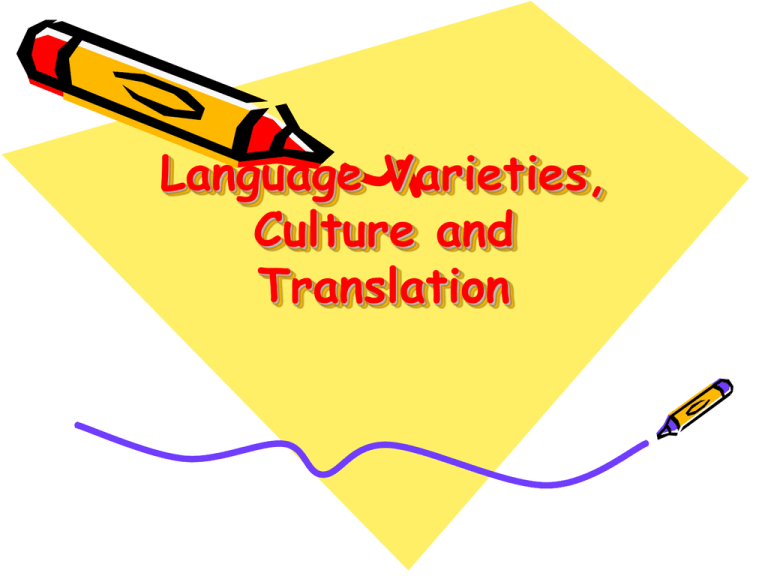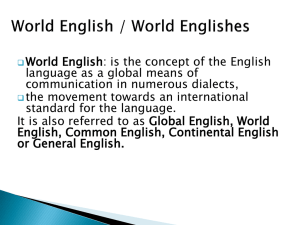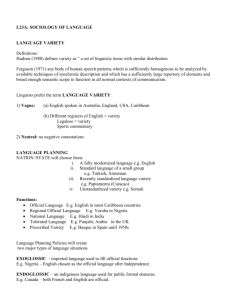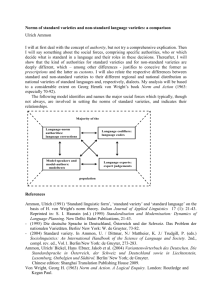Language Varieties, Culture and Translation
advertisement

Language Varieties, Culture and Translation • Introduction: • The present talk will be mainly confined to the varieties of the English language, related culture(s), and the aspects of Translation. The main aim behind this discussion is that language varieties, cultures and translation go hand in hand. They are basically inseparable. Translating a text actually means transferring the linguistic and cultural parallels in the target language. • The term ‘Language Varieties’ means ‘subtype(s)’ of a language on the basis of their difference from one another in terms of ‘Pronunciation’, ‘lexical choice’, ‘grammar’, ‘accent’, etc. • This includes idiolects, dialects, registers, styles and modes, as varieties of any living language. Another view is that of Pit Coder (1973), who suggests dialects, idiolects, and sociolects. Quirk (1972) proposes region, education, subject matter, media and attitude as possible bases of language variety classification of English in particular. Quirk recognizes dialects as varieties distinguished according to geographical dispersion, and standard and substandard English as varieties within different ranges of education and social position. • The term ‘culture’ refers to values, tradition, beliefs, social life, flora and fauna. It is true that each community has its own culture; while one is more materialistic, another is just living on daily hunting. Man is in one way or the other a construct of his culture, and much of his behaviour, values, and goals are culturally determined. Society and culture are clearly reflected in one’s language. In order to understand the dependence of both on each other, try translating the following sentences in your mother tongue(s): • Sentence 1: ‘Your voice is not a sparrow voice in your village.’ • Sentence 2: ‘So you are traitor to your salt-givers.’ • Sentence 3: ‘And they got a coconut and betel-leaf good-bye.’ • Sentence 4: ‘When all the guests arrived, the leaf was laid’. • Sentence 5: ‘He had refused bride after bride, some beautiful as new-opened guavas, and others tender as April mangoes’. What are your reactions / responses? Did you feel something alien: structurally, linguistically and culturally? • Do you know that the Eskimos have seven different expressions / lexicons for the word – snow? What about you!!! Can you differentiate the following: ‘wet snow’, ‘packed snow’, ‘powder snow’, ‘fine snow’, ‘dry snow’, soft snow’. • The Marshalese Islanders don’t have to worry about ‘snow’, but they have sixty terms for parts of the coconut and coconut tree. • What about the cross-cultural misunderstanding of addressing people by names!!! While some prefer to be addressed by the first name, the others feel offended. Someone, new in the United States, from a certain culture, refused to eat “hot dog”. • The north-Indians have many words like, roti, chapati, puri, parotha, tanduri, naan, phulka, kachauri, etc. These words do not have an English parallel. The word that comes closest is “Bread”, but again this is another variety, generally from the bakery - not home made. • Well, given above (in 5 sentences), you found some samples of a variety of Indian English. Mind it, a variety of Indian English!!! This means that we have Indian English, and then some varieties of this Indian English, bearing the variations due to local languages and cultures of the different regions of the Indian subcontinent. • Varieties of English: It is important to mention at the very outset that ‘language varieties’ (Varieties of English in the present context) is the product of ‘Language Contact’, rather than a colonial or post colonial phenomenon. It is just that the majority of the varieties of English received an opportunity for the full flight after the fall of the British Empire in most of its colonies. In other words, a language always carries a number of varieties depending on its contact. • Indeed, for language contact, the language needs to travel. English, for instance, travelled through the globe due to: • The two Diasporas (Kachru 1992: 230-252), and • The recent demand of English after globalization. • The First Diaspora: Movement of the English speakers to such countries as the North America, Australia, New Zealand, etc. • The Second Diaspora: Movement of native speakers as colonizers, mainly to Asian and African countries. • The globalized world boomed the further proliferation of the English language. It convinced even such countries as China, Russia, Saudi Arabia, and many others to accept English for the various practical and functional reasons. • Hence, English, through its contact all over the world, developed quite a good number of varieties, but they failed to receive acceptability, respectability, and repute for centuries (in other words until the dominance of the British Empire). Such varieties received euphemistic and metaphoric nomenclatures. Turner (1966) and Ramson (1970) for instance, called the Australian variety as ‘Transplanted English’. Linguists like Mukherjee (1971) and Quirk (1962) labeled the Indian English as ‘Twice born’ and ‘Interference variety’, respectively. In India alone the early varieties of English were known as ‘Butler English’, ‘Kitchen English’, and ‘Babu English’ depending on the profession of the users. • It is only later in the post colonial phase due to the decline of the British Empire that these varieties got recognition and there emerged ‘new Englishes’ (Plat, Weber and Ho 1984) widening from ‘inner’ to ‘outer’ and ‘expanding circles (Kachru 1985) used in ‘natural, neutral and beneficial’ manner (Pennycook 1994:09) in the three contexts of ENL, ESL, and EFL (Quirk 1962). This has been possible only after a consistent use of English for centuries. This shows a sense of linguistic liberalism, tolerance and acceptability among the users of English. However the prominence of the old native speaker’s prominence can still be seen, when it comes to the fixing of norms, in the name of Standardization and Codification. • Types of Varieties of English: • On the basis of its Diasporas and other factors (like globalization), English has been able to evolve the following types of varieties: • New Englishes (like American, Australian, Italian, Indian, Caribbean, African Englishes; • Dialects (Social (Age, Gender, class,) and Regional • Idiolect (Individual level) • Pidgin and Creole: These two terms are linked in a continuum of language development. Harris (1986) summarizes three conditions for the emergence of a Pidgin variety, namely • a) lack of effective bilingualism; • b) need to communicate; and • c) restricted access to the target language. • Typically pidgin arises when people of many language backgrounds engage in extensive trading, or forced labour, or due to massive population dislocation and movement, and when normal mechanism of language transmission is disrupted. A pidgin is no one’s native language. It is always spoken in addition to one’s native language. A pidgin is often described as “broken” or “fractured”. • A Creole can develop from a pidgin language, if certain social conditions come into play. When a pidgin is used massively by the parents at home and the society in other circumstances (due to whatever reasons), the children growing up in these communities will express their experience of love, fear, and other interactions through this language (pidgin). As they grow older and use it with others of their age, the pidgin develops into a Creole. • The difference between Pidgin and Creole is generally historical and sociological, rather than linguistic. • The above varieties were based on the usage of the language. • Varieties have also been identified on the basis of their Use: • Diglossia (Fishman, 1972 / Ferguson, 1972): “A relatively stable language situation in which, in addition to the primary dialects of the language (may be a standard or regional dialect), there is a very divergent, highly codified (often grammatically more complex) variety, the vehicle of a large and respected body of written literature, either of an earlier time, or in another speech community, which is learned largely by formal education, and is used for most written and formal spoken purposes, but is not used by any sector of the community for ordinary conversation.” A diglossic situation exists in a speech community where two codes perform two sets of functions. This term generally refers to two varieties of the same language. For example, Ferguson refers to Classical Arabic as (H) High and Colloquial as (L) Low. H variety, for instance is used in church and mosques, while (L) variety is used in streets. • Style (variation as per the audience; also as per user, or situation, like it can be formal, cold, frozen, warm) • Register (for Government, law, journalism, …). Variety associated with certain functions or professions. Think of the word “Area”… • Collocation (use of same words in different collocation…) • The Non native varieties of English have also shown a significant expansion in terms of “Range” (refers to context of domains in which English functions, like law, education, business, popular culture, etc) and “Depth” (refers to the Extent of Use of English at the various levels of the society). Depth differs from ESL to EFL contexts, for instance. • Attitude towards Varieties: • Colonial Phase: “My variety versus No Variety”. There was no comparison. The English language belonged to the English / the British. Teaching and learning of English at that time meant teaching and learning of English / British culture too – that is, the customs, traditions, ethics, practices, conventions, beliefs, flora and fauna. The learners of English tried to adopt these along with the language. Their whole outlook, behaviour, and attitude will be closer to the British. In a way the learners used to ape the British. That is why we have such expressions as “Brown Saheb”, “Anglo Indian Culture”, or with anger people would say “Angrez chale gaye, Aulad Chor Gaye” (British have left, but their progeny is still there). • The local varieties were in their infancy. Though India witnessed Indians writing in English (known as Anglo-Indian Literature), a good number of English news papers, and also the first bi-lingual book was published way back in 1793 for teaching English, the English varieties had not been able to attach a respect. Mulk Raj Anand’s first novel in 1930s did not get a publisher until the novel had a Foreword by E.M. Foster – a famous British writer of that time. • • • • • Post colonial phase: “My variety versus other varieties”. To understand the change in attitude, read the following lines of Raja Rao, from the Foreword of his novel Kanthapura– an Indian novel in English: “The telling has not been easy. One has to convey in a language that is not one’s own, the spirit that is one’s own. One has to convey various shades and omissions of a certain thought-movement … alien language. I use the word ‘alien’, yet English is not really an alien language to us. It is the language of our intellectual make up—like Sanskrit or Persian was before—but not of our emotional make up….We cannot write like the English. We should not, we cannot write only as Indians. We have grown to look at the large world as part of us. Our method of expression therefore has to be a dialect which will some day prove to be as distinctive and colorful as the Irish or the American. Time alone will justify it.” (Rao 1996:1) This shows that the ‘aping’ of the early phase has been substituted by a new attitude of using English for one’s own ‘spirit’, ‘shades’, and ‘omissions’. This has been true not only for India, but for the whole of Asian and African continent. • The award winning writers like Salman Rushdie, Arundhati Roy, Jhumpa Lahiri, Chinua Achebe, Wole Soyinka, Kiran Desai, V. S. Naipaul, Amitava Ghosh, and Arvind Adiga are sufficient to suggest that the non native varieties of English have challenged the aspect of the existing standards of the canons of the English language; and that they have attained respectability in the globe today. • Translation: • Now keeping in mind these intricacies of language, we need to think of “translation”. Here you need to understand such terms as: • Auto Translation • Back Translation • Trans-literation (change of script), • Trans-creation (in literature) • Adaptation (in films, esp.) • Auto translation refers to the translation of a text into the target language by the original writer himself. • Back translation: When a text is translated into target language and then the translated text is translated back into the first language then the process is called as the Back Translation. • Summing Up: • To sum up, thus, it is suggested that while translating a text, one needs to identify the variety of language and the implied culture. So that the linguistic and cultural parallels are looked for and applied in order to suit the audience / reader. • That is, if there is a literature based on the slum dweller in Bombay, and if this film is being tran-screated / adapted in Italy, you need to find the parallels.






